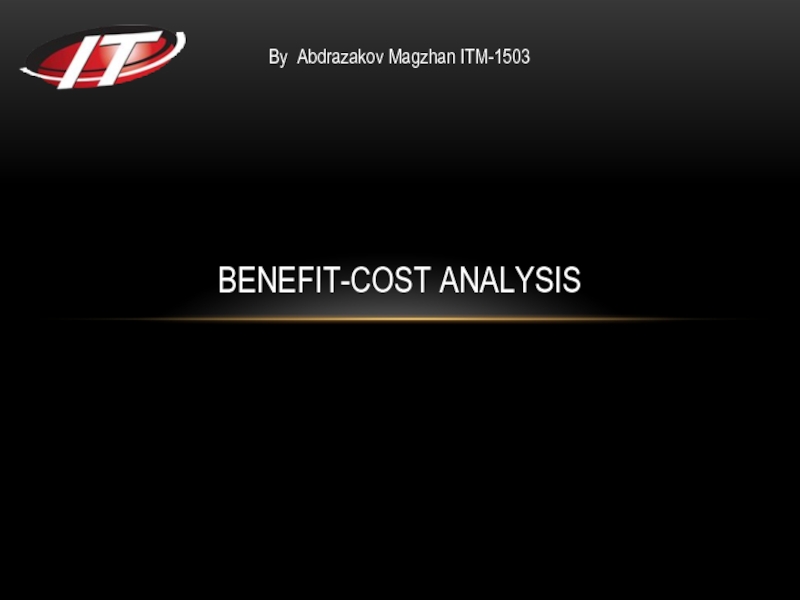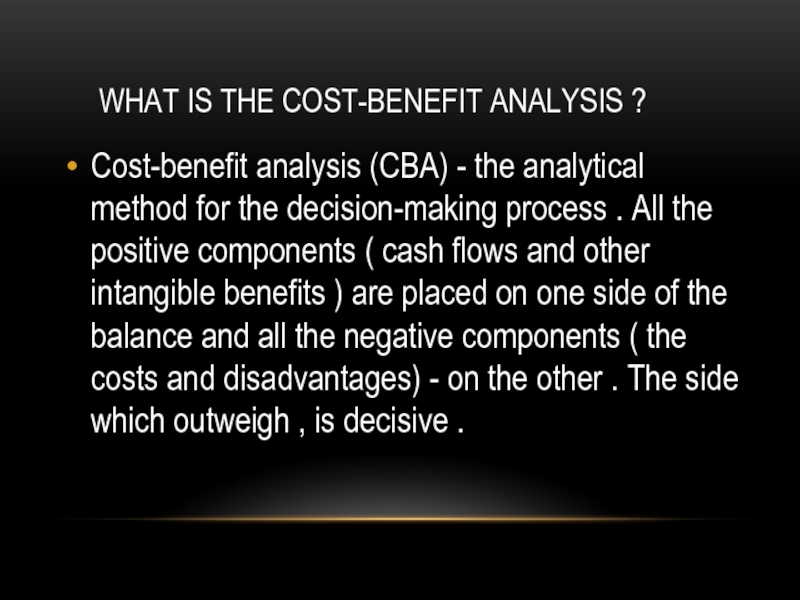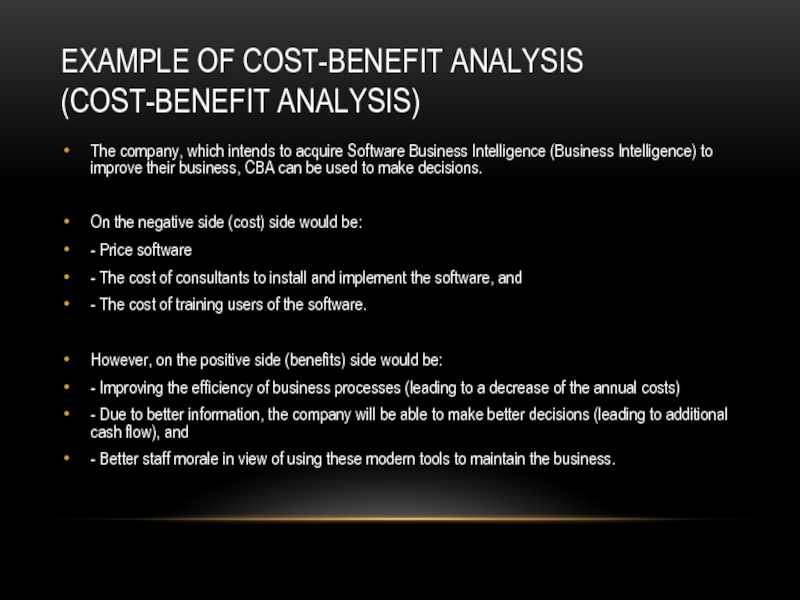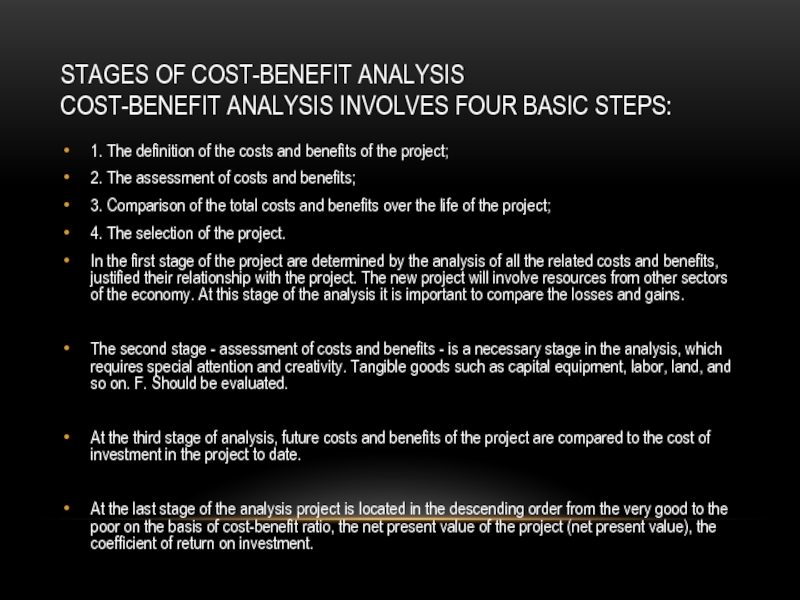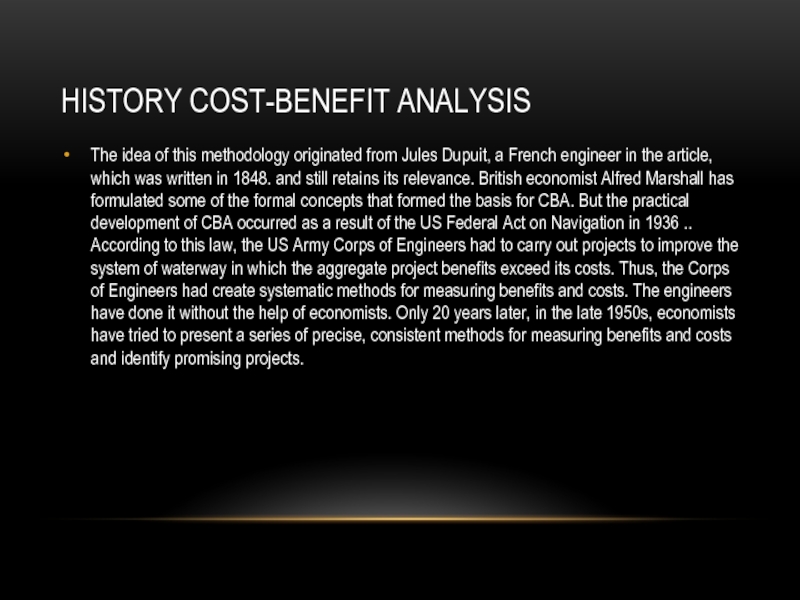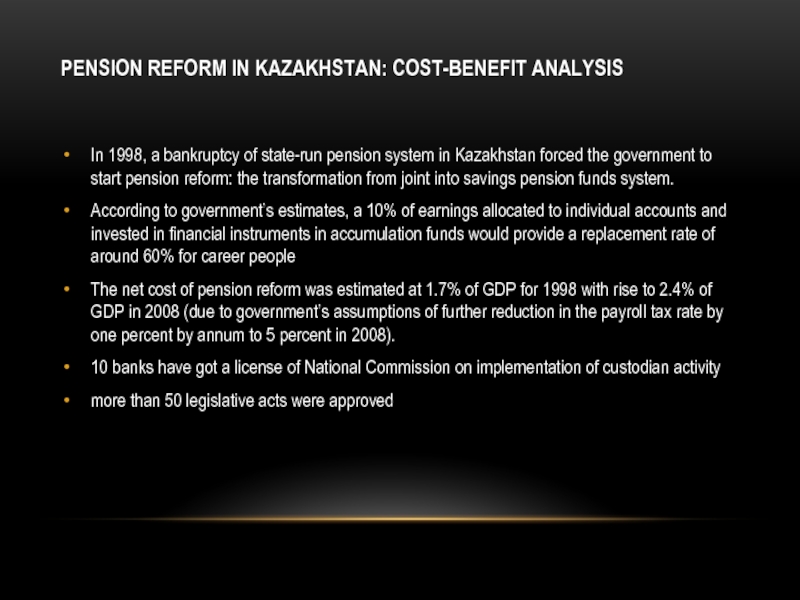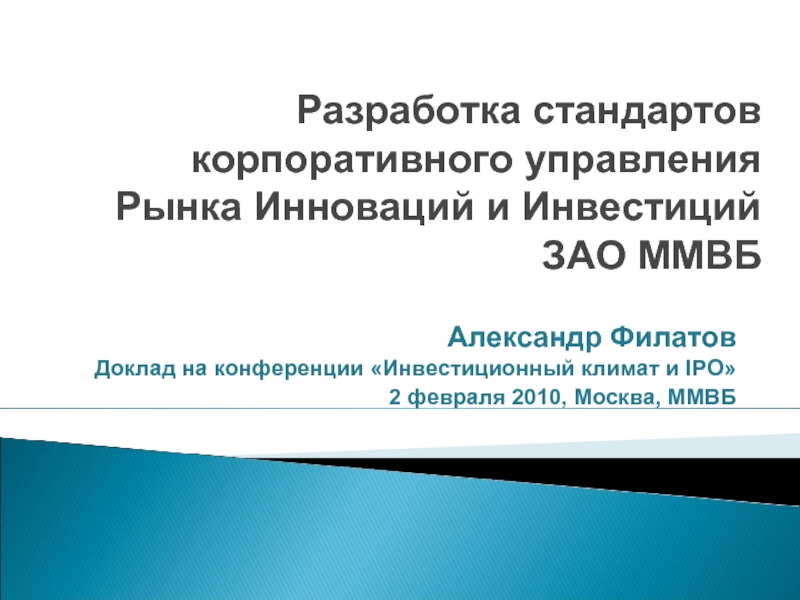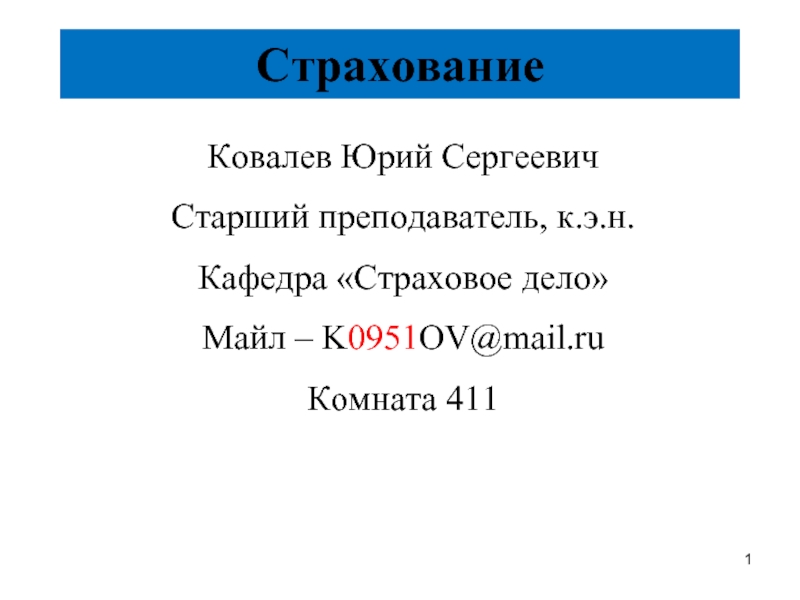- Главная
- Разное
- Дизайн
- Бизнес и предпринимательство
- Аналитика
- Образование
- Развлечения
- Красота и здоровье
- Финансы
- Государство
- Путешествия
- Спорт
- Недвижимость
- Армия
- Графика
- Культурология
- Еда и кулинария
- Лингвистика
- Английский язык
- Астрономия
- Алгебра
- Биология
- География
- Детские презентации
- Информатика
- История
- Литература
- Маркетинг
- Математика
- Медицина
- Менеджмент
- Музыка
- МХК
- Немецкий язык
- ОБЖ
- Обществознание
- Окружающий мир
- Педагогика
- Русский язык
- Технология
- Физика
- Философия
- Химия
- Шаблоны, картинки для презентаций
- Экология
- Экономика
- Юриспруденция
Benefit-cost analysis презентация
Содержание
Слайд 2 WHAT IS THE COST-BENEFIT ANALYSIS ?
Cost-benefit analysis (CBA)
- the analytical method for the decision-making process . All the positive components ( cash flows and other intangible benefits ) are placed on one side of the balance and all the negative components ( the costs and disadvantages) - on the other . The side which outweigh , is decisive .
Слайд 3EXAMPLE OF COST-BENEFIT ANALYSIS (COST-BENEFIT ANALYSIS)
The company, which intends to acquire
Software Business Intelligence (Business Intelligence) to improve their business, CBA can be used to make decisions.
On the negative side (cost) side would be:
- Price software
- The cost of consultants to install and implement the software, and
- The cost of training users of the software.
However, on the positive side (benefits) side would be:
- Improving the efficiency of business processes (leading to a decrease of the annual costs)
- Due to better information, the company will be able to make better decisions (leading to additional cash flow), and
- Better staff morale in view of using these modern tools to maintain the business.
On the negative side (cost) side would be:
- Price software
- The cost of consultants to install and implement the software, and
- The cost of training users of the software.
However, on the positive side (benefits) side would be:
- Improving the efficiency of business processes (leading to a decrease of the annual costs)
- Due to better information, the company will be able to make better decisions (leading to additional cash flow), and
- Better staff morale in view of using these modern tools to maintain the business.
Слайд 4STAGES OF COST-BENEFIT ANALYSIS
COST-BENEFIT ANALYSIS INVOLVES FOUR BASIC STEPS:
1. The definition
of the costs and benefits of the project;
2. The assessment of costs and benefits;
3. Comparison of the total costs and benefits over the life of the project;
4. The selection of the project.
In the first stage of the project are determined by the analysis of all the related costs and benefits, justified their relationship with the project. The new project will involve resources from other sectors of the economy. At this stage of the analysis it is important to compare the losses and gains.
The second stage - assessment of costs and benefits - is a necessary stage in the analysis, which requires special attention and creativity. Tangible goods such as capital equipment, labor, land, and so on. F. Should be evaluated.
At the third stage of analysis, future costs and benefits of the project are compared to the cost of investment in the project to date.
At the last stage of the analysis project is located in the descending order from the very good to the poor on the basis of cost-benefit ratio, the net present value of the project (net present value), the coefficient of return on investment.
2. The assessment of costs and benefits;
3. Comparison of the total costs and benefits over the life of the project;
4. The selection of the project.
In the first stage of the project are determined by the analysis of all the related costs and benefits, justified their relationship with the project. The new project will involve resources from other sectors of the economy. At this stage of the analysis it is important to compare the losses and gains.
The second stage - assessment of costs and benefits - is a necessary stage in the analysis, which requires special attention and creativity. Tangible goods such as capital equipment, labor, land, and so on. F. Should be evaluated.
At the third stage of analysis, future costs and benefits of the project are compared to the cost of investment in the project to date.
At the last stage of the analysis project is located in the descending order from the very good to the poor on the basis of cost-benefit ratio, the net present value of the project (net present value), the coefficient of return on investment.
Слайд 5HISTORY COST-BENEFIT ANALYSIS
The idea of this methodology originated from Jules Dupuit,
a French engineer in the article, which was written in 1848. and still retains its relevance. British economist Alfred Marshall has formulated some of the formal concepts that formed the basis for CBA. But the practical development of CBA occurred as a result of the US Federal Act on Navigation in 1936 .. According to this law, the US Army Corps of Engineers had to carry out projects to improve the system of waterway in which the aggregate project benefits exceed its costs. Thus, the Corps of Engineers had create systematic methods for measuring benefits and costs. The engineers have done it without the help of economists. Only 20 years later, in the late 1950s, economists have tried to present a series of precise, consistent methods for measuring benefits and costs and identify promising projects.
Слайд 6PENSION REFORM IN KAZAKHSTAN: COST-BENEFIT ANALYSIS
In 1998, a bankruptcy of state-run
pension system in Kazakhstan forced the government to start pension reform: the transformation from joint into savings pension funds system.
According to government’s estimates, a 10% of earnings allocated to individual accounts and invested in financial instruments in accumulation funds would provide a replacement rate of around 60% for career people
The net cost of pension reform was estimated at 1.7% of GDP for 1998 with rise to 2.4% of GDP in 2008 (due to government’s assumptions of further reduction in the payroll tax rate by one percent by annum to 5 percent in 2008).
10 banks have got a license of National Commission on implementation of custodian activity
more than 50 legislative acts were approved
According to government’s estimates, a 10% of earnings allocated to individual accounts and invested in financial instruments in accumulation funds would provide a replacement rate of around 60% for career people
The net cost of pension reform was estimated at 1.7% of GDP for 1998 with rise to 2.4% of GDP in 2008 (due to government’s assumptions of further reduction in the payroll tax rate by one percent by annum to 5 percent in 2008).
10 banks have got a license of National Commission on implementation of custodian activity
more than 50 legislative acts were approved
